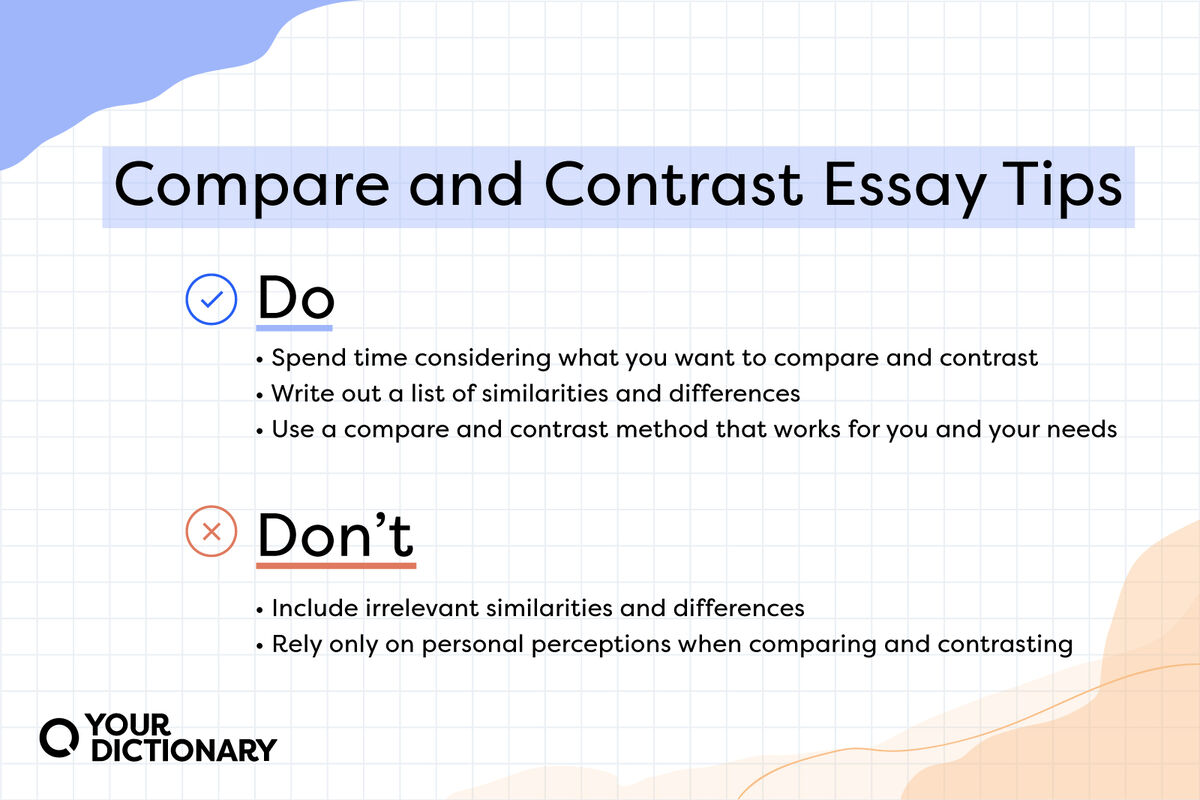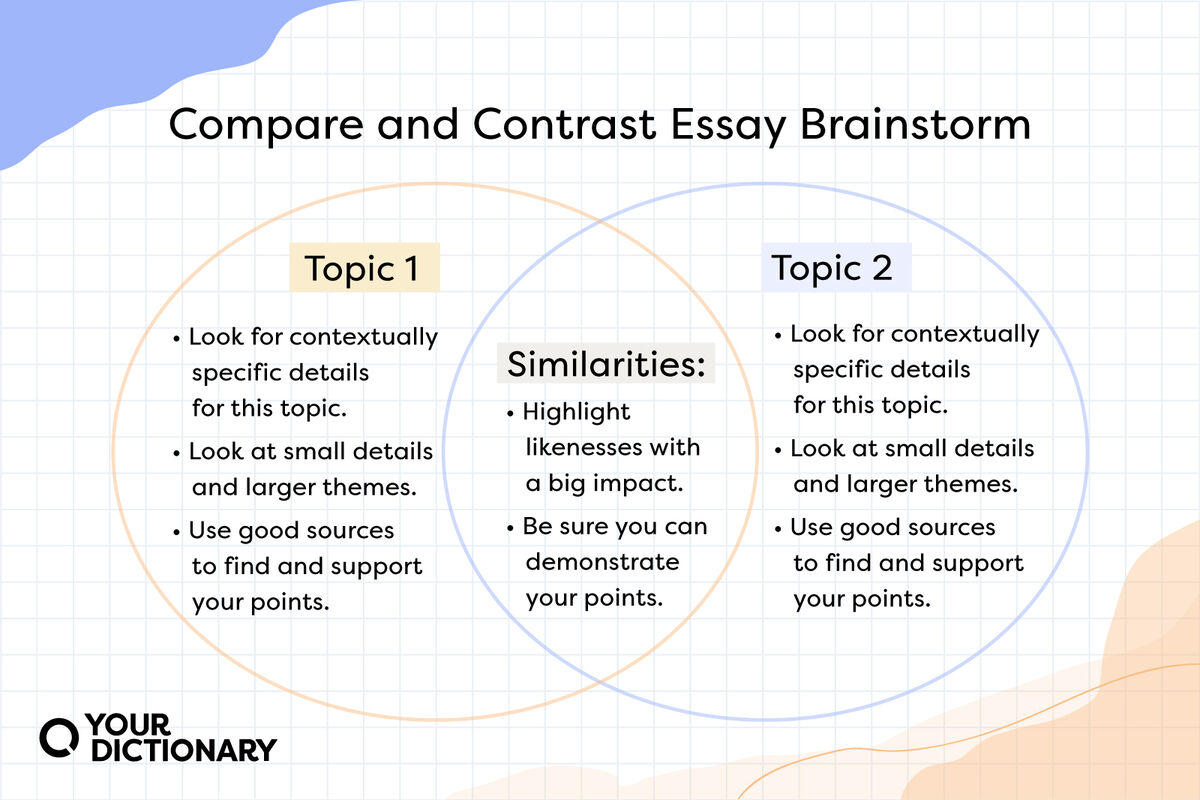
Have you ever been at the grocery store, looked at the two bins of sweet potatoes and yams, and wondered, "What’s the difference?" Congratulations! You’ve done a mini version of the compare and contrast essay. Granted, compiling all those thoughts about starchy tubers into words poses its own challenge, but don’t worry. With a few simple tips, you’ll be comparing and contrasting with the best of them.
Understand What “Compare” and “Contrast” Even Mean
Before you even get to your starch-based analysis, it’s worth understanding what people (i.e., your instructors) even mean when they talk about comparing and contrasting.
Compare is a verb meaning “to speak of or represent as similar; to liken,” while contrast means “to set in opposition to show different qualities and characteristics.”
In layman’s terms, it’s analyzing the similarities and differences in two like subjects, though it’s also more than just that. For example, if you were to “compare” two people by saying:
They both have eyes. They have hair. They have skin. They require food, oxygen, and water. They have legs.
That’s not particularly interesting or incisive, nor is it much of an analysis. You just described two mammals.
A compare and contrast essay requires deeper thought. Physical features might factor into that, sure, but the more important thing to consider is “Why does it matter?” Consider how similarities or differences might have informed intent, artistry, or life journeys. Those considerations can hopefully deliver some sort of greater insight about life, humanity, and art. That’s the whole purpose of the compare and contrast essay.
Focus More on Framing, Less on “Like Subjects”
Figuring out “like subjects” to compare and contrast comes with its own challenges. You probably wouldn’t write an essay looking at the similarities and differences between your grandfather and a baked potato, but what about two artists who worked in different mediums? Or a video game character and a character from a movie?
In reality, you could compare and contrast whatever you wanted (maybe even Grandpa and a baked potato), but a lot of it comes down to framing. If you want to compare artists of different mediums, maybe they worked within the same movement or tradition, like retrofuturism. How do themes of retrofuturism influence the two artists?
If you want to compare a video game character to a film character, even if they’re from different mediums, consider how that difference affects how you interact with or interpret those characters.
Simplify Your Topic Selection
Thinking more about framing is definitely the key to figuring out how to get into your writing, but choosing a topic is understandably daunting. As you're choosing a topic, use the K.I.S.S. method and keep it simple.
The main things to consider:
- The two subjects need to have some sort of demonstrable overlap.
- Figuring out differences is almost always easier than finding similarities.
- Even similarities/differences that seem obvious to you might not be obvious to a reader.
Start With a Simple Brainstorm
Before you even think too hard about the overall structure of your compare and contrast essay, it's helpful to start with a good old-fashioned list. Take a sheet of paper; draw a vertical line down the center; and list the similarities and differences between the two subjects. This is basically a Venn diagram but in list form.

For example, if you’re writing an essay about two famous painters, start with their similarities. Perhaps they both painted with acrylics or were drawn to similar subjects. Once you've covered as many similarities as you can, move on to their differences. Monet started studying at an early age, while Van Gogh started in pastoral studies before developing an interest in art in his 20s.
| Vincent Van Gogh | Similarities | Claude Monet |
| Self-portraits, portraits, landscapes, still lifes | Oil painters | Mostly landscapes |
| Started art profession later in life (in his 20s) | Influenced by impressionists | Studied art at an early age |
| Dutch | Rejected realism | French |
| Bold, striking use of color | A lack of straight lines or linear perspective | Realistic, natural use of color |
| Died by suicide at 37 | Died of lung cancer at 86 | |
| Post-impressionist | Impressionist |
Much like any part of your essay, you can change this, add new similarities and differences, and otherwise make this list useful to you.
Choose an Outline Structure Based on Your Subject and Assignment
Now that you’ve constructed a list of things to compare and contrast, you can start building out the structure of your essay with (you guessed it) an outline. The introduction and conclusion of your essay will largely be similar to other essays, but the body paragraphs are where compare and contrast essays really set themselves apart.
Obviously, the body is where you’ll do the actual comparing and contrasting, but there are a few different ways to actually approach that. None of these methods is wrong or “better,” but you might change your approach based on your topic or the amount of time that you have.
Compare and Contrast Essay Outline: Quick and Focused
This is maybe the most basic structure for a compare and contrast essay. With this method, you write one body paragraph with all the similarities of your two subjects and one body paragraph covering all the differences.
Given our example about Van Gogh and Monet, that outline might look like:
- Introduction
- Background context about Van Gogh and Monet
- A thesis statement about what you’re comparing and contrasting regarding Van Gogh and Monet and why
- Body paragraph #1: Similarities of Van Gogh and Monet’s artistic styles
- Body paragraph #2: Differences between Van Gogh and Monet's artistic styles
- Conclusion
- Restating the thesis
- Summing up the importance of Van Gogh and Monet in their similarities and differences
It’s not the most ideal for in-depth analyses (unless you want extremely large, unwieldy paragraphs). However, if you’re focusing on a single comparison point or writing a timed essay, this can be an easy, effective, and succinct method to organize your thoughts.
Compare and Contrast Essay Outline: The Block Method
The block method involves grouping all your points about your first subject together into a block of paragraphs and grouping all of your points about your second subject into a block of paragraphs (while analyzing similarities and differences).
- Introduction
- Body paragraph #1
- A look at Van Gogh’s life
- Body paragraph #2
- Van Gogh’s artistic style
- Body paragraph #3
- A look at Monet’s life (and how it compares to Van Gogh’s)
- Body paragraph #4
- Monet’s artistic style (and how it compares to Van Gogh’s)
- Conclusion
This method of comparing and contrasting works better on shorter papers or more focused topics. With more in-depth analyses, things can easily get confusing. For example, if you’re talking about Van Gogh’s art, his most famous paintings, his legacy, and his importance to artistic canon, a reader might forget about Van Gogh’s biography by the time you even get to writing about Monet’s life.
Compare and Contrast Essay Outline: The Point-by-Point Method
The point-by-point method can give you a little more flexibility, whether you’re writing a five-paragraph essay or a longer paper with more in-depth comparisons. With this method, each body paragraph covers a specific point about both subjects, including the similarities and differences.
- Introduction
- Body paragraph #1: Biography
- Van Gogh’s life
- Monet’s life
- Body paragraph #2: Artistic style
- Van Gogh’s artistic style
- Monet’s artistic style
- Body paragraph #3: Legacies
- Van Gogh’s legacy
- Monet’s legacy
- Conclusion
This method keeps things close together, so you know exactly what is being compared between your two subjects.
Follow the Evidence
Finding some credible sources to backup your essay points serves two important purposes. First, the evidence you find can inform new similarities and differences. Maybe it turns out that the two artists grew up in similar environments. Maybe new discoveries about Grandpa show that he has the same inner warmth as a baked potato. These are all things you might have overlooked without the right research.
Second, once you're comfortable with your topic and the direction of your essay, use evidence to support your points. In these types of informative or analytical essays, statistical evidence is helpful. This includes:
- Facts and stats
- Scholarly articles
- Testimonials
- Expert opinion from known critics and academics
- Personal encounters